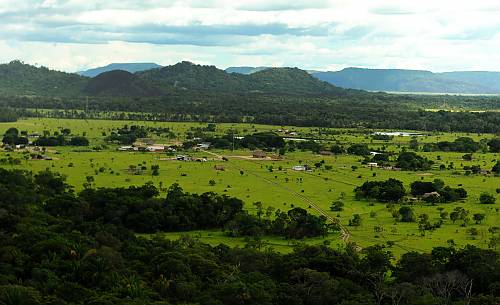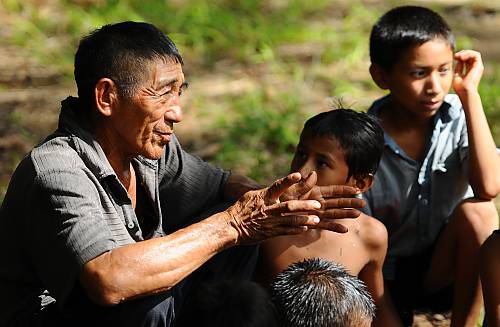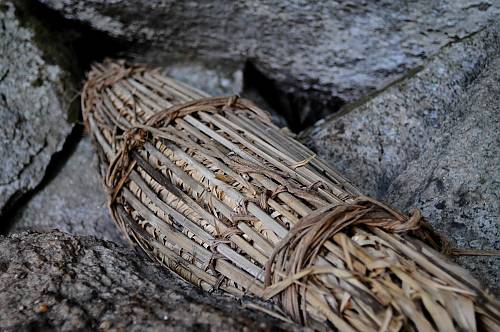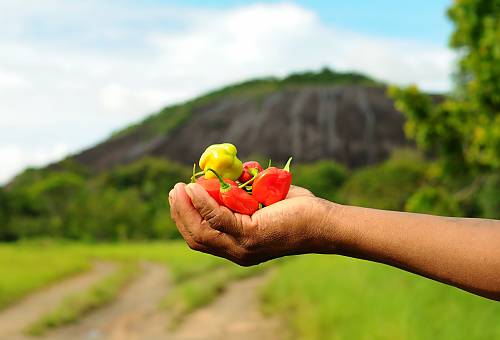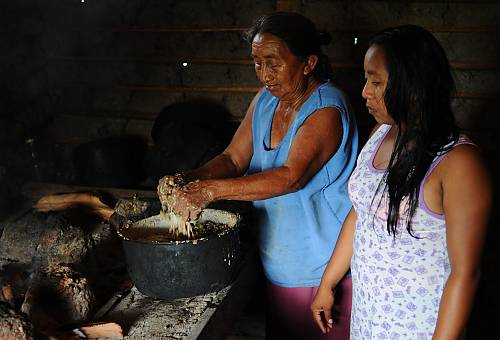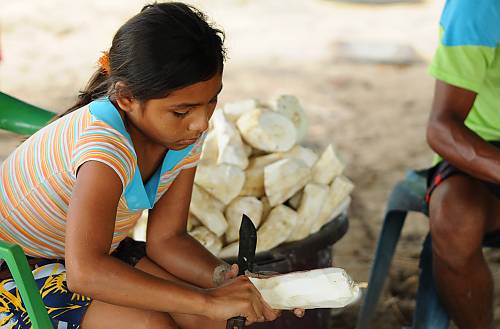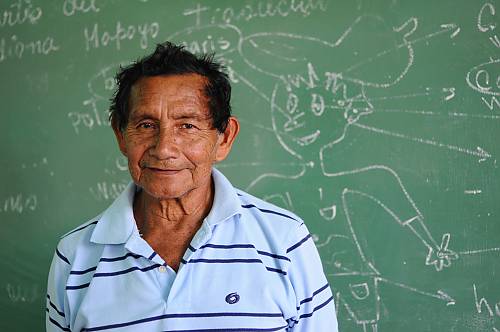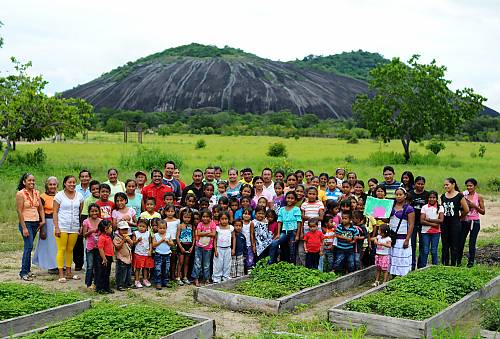Rapport sur l'état d'un élément inscrit sur la liste du patrimoine culturel immatériel nécessitant une sauvegarde urgente
A. Page de couverture
A.1.
État partie
Nom de l'État partie
Venezuela (République bolivarienne du)
A.2.
Date du dépôt de l'instrument de ratification, d'acceptation, d'approbation ou d'adhésion
Elle peut être consultée en ligne.
Date of deposit of the instrument of ratification, acceptance, approval or accession
2007-04-12
A.3.
Élément inscrit sur la Liste de sauvegarde urgente qui fait l'objet du présent rapport
Nom de l'élément
Report of Venezuela on the status of the element 'Mapoyo oral tradition and its symbolic reference points within their ancestral territory'
Inscrit en
2014
État(s) soumissionnaire(s)
Venezuela (République bolivarienne du)
A.4.
Période considérée dans le présent rapport
Veuillez indiquer la période couverte par le présent rapport.
A.5.
Autres éléments inscrits sur la Liste de sauvegarde urgente, le cas échéant
Veuillez établir une liste de tous les autres éléments présents sur le territoire de votre pays qui sont inscrits sur la Liste de sauvegarde urgente et indiquer en quelle année ils y ont été inscrits ; pour ce qui est des éléments multinationaux, veuillez indiquer quels autres États sont concernés.
A.6.
Synthèse du rapport
Veuillez fournir une synthèse du rapport, qui permette au grand public de comprendre l'état actuel de l'élément, mentionne toute incidence positive ou négative de son inscription et fasse état des mesures de sauvegarde mises en œuvre pendant la période considérée et leur possible mise à jour les années suivantes.
A.7.
Personne à contacter pour la correspondance
Donnez le nom, l'adresse et les coordonnées d'une personne à qui toute correspondance concernant le rapport doit être adressée.
Titre (Mme/M., etc.)
Mr
Nom de famille
Amaíz
Prénom
George
Institution/fonction
Coordinador de la Oficina Técnica
Adresse
Centro de la Diversidad Cultural
Avenida Panteón, Foro Libertador, Edificio de la Biblioteca Nacional AP-4
Distrito Capital, Municipio Libertador
Caracas
Numéro de téléphone
+58 212 564 9822
Adresse électronique
amaizg@gmail.com
Autres informations pertinentes
B
Mr
B. État de l'élément inscrit sur la Liste de sauvegarde urgente
Veuillez vous référer au dossier de candidature ou aux précédents rapports, le cas échéant, pour savoir quand établir un rapport sur l'état actuel de l'élément et ne rendez compte que des changements pertinents survenus depuis la date de son inscription sur la Liste ou depuis le précédent rapport. Les dossiers de candidature, les calendriers spécifiques et les précédents rapports, le cas échéant, sont disponibles à l'adresse suivante : https://ich.unesco.org ou peuvent être demandés au Secrétariat.
L'État partie s'efforce de prêter une attention particulière au rôle du genre et d'assurer la plus large participation possible des communautés, des groupes et, le cas échéant, des individus concernés ainsi que des organisations non gouvernementales pertinentes pendant le processus de préparation de ce rapport ; il lui est demandé au point D ci-dessous de décrire de quelle manière il y est parvenu.
B.1.
Fonctions sociales et culturelles
Expliquez les fonctions, les significations sociales et culturelles de l'élément aujourd'hui, au sein et pour ces communautés, les caractéristiques de ses détenteurs et de ses praticiens et décrivez, entre autres, toute catégorie de personnes exerçant un rôle ou des responsabilités spécifiques vis-à-vis de l'élément. Une attention particulière devrait être accordée à tout changement pertinent susceptible d'avoir des répercussions sur le critère d’inscription U.1 (« L’élément est constitutif du patrimoine culturel immatériel tel que défini à l'article 2 de la Convention »).
Social and cultural functions
The element allows to preserve the identity and worldview of the Mapoyo people. Since its inscription in the LSU, “being Mapoyo” has gained force; as their bearers say, the community is aware now, especially the elders. This has meant that there is a strengthening of the culture and bigger love for it from its own grassroots structures.
For Mapoyo people, the revitalization of their culture lies in their elders, their children and in the transmission of the ancestral knowledge from the first ones to the second ones. Such transmission occurs in formal education environments and homes, having the family as the space where most of the cultural revitalization processes take place, including social cohesion through practices linked to the element. In this regard, since the previous report, a greater involvement of youngsters in ancestral practices has been reported, taking as an example “moriche” knitting, fishing, sowing, and food production.
In formal education environments, the use of Mapoyo language has gained force among youngsters. Thanks to this linguistic reinforcement, it was possible to translate the National Anthem of Venezuela and the well-known song “Venezuela.” In this regard, the inscription of this Intangible Cultural Heritage before the UNESCO Convention 2003 also allowed this indigenous community to have more presence in different spaces of the national reality. Along this process of accountability, the message of Mapoyo people has always been consistent and clear: “Mapoyo culture is alive, and we are proud of it.”
Mapoyo people have maintained the transmission of their narrative related to the social organization, for example, stories like “mass suicide” and “we are Mapoyo,” a representation of how proud they are of their culture. Thanks to these stories, children have acquired a set of social norms, including values and humanness. Each story has a unique social function - recreated in their own geography - that allows the preservation of the territory by the community.
On the other hand, the efforts to build intercultural bridges between Mapoyo people and the Venezuelan daily reality aim to make youngsters go beyond their communities and learn a trade; then, they will return - as it has been the case in the last four years - as teachers and nurses in order to give back what they learnt, without losing their cultural identity.
Since 2002, Mapoyo people participate - along with the Ministry of People’s Power for Ecosocialism - in the turtle breeding farm project called Tortuga del Orinoco, an endangered species. In these spaces, children learn to preserve nature while favoring their social cohesion, reinforcing the vitality of their language. At the same time, these efforts allow the strengthening of their sense of territoriality and symbolic geography as part of their ancient practices. Every Mapoyo is convinced that without nature their culture would disappear.
B.2.
Analyse de sa viabilité et risques auxquels il est actuellement exposé
Décrivez le degré actuel de viabilité de l'élément, en particulier la fréquence et l'étendue de sa pratique, la vigueur des modes de transmission traditionnels, la composition démographique des praticiens et des publics, et sa durabilité. Veuillez aussi identifier et décrire les facteurs qui, le cas échéant, constituent une menace pour la pérennité de la transmission et de la représentation de l'élément et indiquez le degré de gravité et de proximité de tels facteurs, en accordant une attention particulière à tout renforcement ou affaiblissement de la viabilité de l'élément suite à son inscription.
Assessment of its viability and current risks
Since the last report, in which different vulnerable practices linked to the element were identified, efforts have been double in order to strengthen such vulnerabilities within the community, especially among young members. The element is feasible due to its daily frequency. Likewise, Mapoyo language has been reinforced in its everyday practice, reaching a strong foothold in terms of identity, as expressed by the same elder bearers when they say “today, there are more Mapoyo.”
Practices linked to hunting, fishing, and agriculture have been reinforced since the last report. The youngest members request to participate in these activities and they learn archery, including other elements linked to these type of activities. The community, including children, women, and elders, is responsible for the goods obtained through hunting, fishing or gathering; at the same time, such goods are equally distributed among all members. This strengthens the sense of community.
It is important to highlight that during the term corresponding to this report, the world faced the COVID-19 pandemic which also affected the Mapoyo people; however, the impact on Mapoyo community was not that negative if compared to other populations around the world. Mapoyo people faced the pandemic with their ancient wisdom and their medicinal plants; they managed to counteract the effects of the virus, and nobody died from such lethal and evil disease. They even gave the disease a nickname: “el covito” since it did not seem to be as hard as it was said. Nonetheless, these processes had positive consequences such as the strengthening of the traditional medicine within the community, and transmission of knowledge to young members, including the transcendence of the preservation of the environment since the knowledge of those plats helped the community overcome such difficult times.
The community has also received the support of the Ministry of People’s Power for Ecosocialism in the preservation of the environment by training young members as park rangers, since Mapoyo people seek harmony between their members and the nature, as defenders of their natural habitat.
The presence of violent groups and the illegal mining in the Mapoyo territory represent a constant thread. Young members feel attracted to those activities due to the money they produce; however, they suffer abuse and discrimination by miners. The non-compliance of the agreements by national mining companies is another constant thread; they don’t follow the security standards on waste management resulting from mining activities, nor comply with reforestation. This lack of institutional will is also expressed in the non-compliance of certain agreements intended to support the Mapoyo community. For instance, during the term of this report, the structure of the Community Museum was terribly affected, and Mapoyo people have not received the necessary institutional support to repair it; this represents a thread for the transmission of the Mapoyo way of life to other communities, groups or individuals, including the very same members of Mapoyo community.
B.3.
Mise en œuvre des mesures de sauvegarde
Veuillez rendre compte des mesures de sauvegardes qui ont été décrites dans le dossier de candidature et dans un précédent rapport, le cas échéant. Décrivez de quelle manière elles ont été mises en œuvre et ont contribué de façon substantielle à la sauvegarde de l'élément au cours de la période considérée, en tenant compte des contraintes externes ou internes telles que des ressources limitées. Incluez en particulier des informations sur les mesures prises afin d'assurer la viabilité de l'élément en permettant à la communauté d'en poursuivre la pratique et la transmission. Fournissez les renseignements suivants en ce qui concerne la mise en œuvre de l’ensemble des mesures de sauvegarde ou du plan de sauvegarde :
B.3.a.
Objectifs et résultats
Indiquez quels objectifs principaux ont été atteints et quels résultats concrets ont été obtenus pendant la période considérée.
Objectives and results
In order to make Mapoyo culture more visible, and strengthen the process of language and knowledge transmission, in 2018-2022 the implementation of learning projects in the classroom continued, guided by teachers and elder members from El Palomo community. Thanks to this, today the children know more about their culture and are proficient in their language. Classroom practices aiming to strengthen the use of their language continued. As a result, when children go to sixth grade they reach up to 60% of language proficiency. At the same time, it was possible to translate some songs such as the National Anthem and “Venezuela” so kids are able to sing those songs to national authorities and indigenous communities in different events, showing they can actively pass their culture.
The recreational realm has contributed to the cultural promotion through theater plays based on Mapoyo knowledge, for instance, those that revolve around the mythical “mass suicide.” Besides, the revival of traditional children’s games such as “Peste Coco” (a ball made out of corn husk), and archery have been recurring activities. These promotion activities have had a positive impact among Mapoyo people; today, they feel they are more visible in the national sphere if compared to previous years.
Based on the main goal - which is reducing the threats on the ancient Mapoyo territory - the community, institutions and researchers who support this cause have followed the land demarcation process achieved in 2013, through a collective title that guarantees Mapoyo people the property of 261,493.29 hectares. For this, there has been an effective discussion and implementation of what they call Rules of coexistence, that allow the permanence of other nine indigenous groups in such area. These rules aim to guarantee the permanence of these different groups in that area and foster the characteristic brotherhood of Venezuelan and Latin American indigenous groups.
Other goals that have been achieved are linked to environmental preservation and awareness. For instance, Mapoyo people have been participating in a turtle breeding farm project to preserve the Arrau turtle, an endangered species. Thanks to this reservoir, it was possible to go from 30 nesting turtles to 2,000, laying down a great number of eggs in 2022. The project was implemented under the guidelines provided by the Ministry of People’s Power for Ecosocialism.
B.3.b.
Activités de sauvegarde
Dressez la liste des principales activités menées au cours de la période considérée pour obtenir ces résultats escomptés. Veuillez décrire les activités en détail en mentionnant leur efficacité et tout problème rencontré dans leur mise en œuvre.
Safeguarding activities
Transmission of ancient knowledge
During the term of this report, the Education Program of Mapoyo people continued. This program aims to strengthen the transmission of ancient knowledge among younger generations, including the native language guided by local teachers and the Council of Elders. This strategy has been very successful, and it has aroused interest in history and Mapoyo culture among children.
Today, thanks to the progress of this program, elementary school children are almost fluent in their native language; they are able to communicate with their grandparents and teachers in a proper way. Teaching an ancient language, in particular, has increased the number of students who reach sixth grade and are able to understand and speak Mapoyo language.
All this knowledge around language and the use of the symbolic contents in the community have become stronger. Evidence of this can be seen in cultural activities performed inside and outside of those areas inhabited by Mapoyo people. Thus, the translation of songs that will be sung in schools or institutions inside or outside the community has turned children into active promoters of their ancient knowledge.
The safeguarding actions implemented by Mapoyo people have also allowed the population, especially young members, to get closer to their traditional instruments, dances and the performance of ancient rituals. Traditional games and indigenous sport competitions have also been rescued. Also, new generations have learned about work, management of natural resources, including information about diets, medicinal plants, house construction, childbearing and delivery care, and other knowledge that help them face daily and extraordinary situations based on the ancient knowledge of this community.
ICH - Research
During 2022, "Oro Azul company", a joint venture with private and government participation, conducted an environmental impact assessment and a socio-cultural research of the Sacred Sites within the Mapoyo territory. The specialists involved in this research were professor Nury Orijuela, from the Central University of Venezuela; and sociologist Ángel Soublette. Likewise, between 2021 and 2022 a Colombian certifying officer came to promote a potential research process around the self-sustaining practices implemented by the community.
Education for Safeguarding
Between 2018 and 2022, the practices to strengthen the transmission of Mapoyo language continued, focused on fifth and sixth grade students; these actions were guided by teachers, grandparents and community leaders. Among other education activities, there is the creation of a Mapoyo dictionary, including terminology that will contribute to language teaching. Today, this project is under construction and research, and it is conducted by members of El Palomo community. On the other hand, Mapoyo people have reported that after a hard effort by the community before the national education authorities, a high school will be open in El Palomo; there, they will continue with the same spirit of safeguarding of the local ICH, taught to students in early and elementary education.
Promotion of ICH
In previous years, the Murukuní Community Museum was an important place for Mapoyo cultural transmission, and hosted several exhibitions about the origin and history of Mapoyo people. The museum also presented cultural performances and many other activities that allowed the promotion of community knowledge. However, during this term, the museum has been closed due to a serious damage in its structure, and there is not a place to perform such activities.
This museum is very important for the promotion and visibility of the Mapoyo culture; in this regard, the restoration of this space for the safeguarding of these activities is a priority. The community has developed a plan to reactivate the museum by using indigenous elements; however, the restoration requires the participation of specialized technical staff, funding and machinery.
Land demarcation
In 2013, the community received the collective title of the ancient Mapoyo territory; for this, it was necessary to conduct a series of researches including the water toponym of the region, the hunting and gathering sites, and other areas linked to the history and cultural identity of Mapoyo people. During 2018 - 2022, the recognition process by the State is considered to be finished, but it is always subject to follow-up; this is a reason why the Rules of Coexistence stablished are essential. In this regard, it is very important to highlight how satisfied the Mapoyo people are about this accomplishment, since this is a strong recognition of their ancient heritage, including as well the consideration of the territory for the life and continuity of their people.
As per the prior considerations, the Arco Minero del Orinoco project is a latent risk for this accomplishment; the exploitation of some of the natural areas included in such project has an impact on the demarcated territory. In order to minimize the differences and strengthen the coexistence between indigenous groups, mining companies and other stakeholders in the area, the Mapoyo community created the Council of people and indigenous communities from the Mapoyo ancient territory / ICH-TAM, as a way to safeguard and protect the land demarcation achieved. In this current period, there is a continuous work on the expansion of these Coexistence Rules that allow the permanence of nine indigenous groups - different from Mapoyo people - in their territory, including industries, locals, and merchants who also live in this area.
B.3.c.
Participation de communautés, de groupes ou d'individus aux activités de sauvegarde
Veuillez décrire de quelle manière les communautés, les groupes ou, le cas échéant, les individus ainsi que les organisations non gouvernementales pertinentes ont participé de façon effective à l'exécution des mesures de sauvegarde, y compris en termes de rôles du genre. Décrivez le rôle joué par l'organisation ou l'organe chargé de l'exécution (dénomination, informations de référence, etc.) et les ressources humaines qui ont été mises à disposition pour la mise en œuvre des activités de sauvegarde.
Participation of communities, groups or individuals in the safeguarding activities
Meetings with and between bearers of the element to exchange knowledge, education programs, research and promotion projects, including exhibitions about the element are the main activities developed to safeguard the culture. In this regard, the “Mapoyo meeting 2022” which took place in Caracas, allowed the assessment of the status of the relevance and significance of the existing measures; at the same time, this activity supported some ideas that contributed to the implementation of new safeguarding actions taking into account the reality, the problems and current aspirations of Mapoyo people in the short and medium term.
Based on this, Mapoyo people have had a central role in the development and implementation of such lines of actions, always from the guidance and wisdom of their chief, Simón Bastidas; their captain, Argenis Bastidas; and their council body, all of them Mapoyo. It is important to highlight that every decision or action implemented has had the prior approval of every Mapoyo member from El Palomo community.
Bearers have continuously revitalized the transmission of their ancient knowledge, and different generations participate in the implementation of measures adopted, and this is reflected in their daily life. Nonetheless, the Safeguarding plan - since the implementation of the “Mapoyo meetings,” including the efforts to guarantee the continuity of the ICH - has been based on the adoption of frequent communication channels, through digital media, between the “Mapoyo world” and their institutional peers.
However, and as a complementary part of the aforementioned strategy, in December 2021, on-site meetings between Mapoyo people and technical staff linked to the Safeguard Plan resumed, especially since it was this staff who visited the ancient Mapoyo territory. Based on this, the meetings between Mapoyo representatives, officials from the Center for Cultural Diversity, and heads of CVG-Bauxilum company have been particularly important and satisfactory. The objective of these meetings is making CVG-Bauxilum assume their responsibility, commitment and duties regarding the Safeguarding Plan of the Mapoyo oral tradition and its symbolic reference points within their ancestral territory, aimed basically to the safeguarding and preservation of the environment, often destroyed by their mining actions.
On the other hand, the public sector, with their technical support, is committed to comply with the rest of the safeguarding measures, including those that will potentially be included in the plan for the following years. Based on this, the State has delegated the Center for Cultural Diversity to coordinate along with the Mapoyo people such initiatives in favor of the safeguarding process.
B.3.d.
Calendrier
Indiquez, sous forme de calendrier, les dates de mise en œuvre de chacune des activités.
Timetable
- Classroom projects were conducted during the whole term. There, different traditional activities were reinforced: knitting, production of bows and arrows, and games such as “Peste coco.”
- In the last four years, there were community assemblies for decision making processes on different subjects, especially on how to face COVID-19 from an inherited ethnomedical approach.
- The “sarrapia” (Tonka bean) is a very important plant for the economy of El Palomo; it was collected during the whole period. The participation of children in the process was a very interesting aspect; it had a positive impact on the transmission of the values linked to the element.
- In 2019, with the support of the Ministry of People’s Power for Ecosocialism, there were park ranger courses for young people. The objective was to strengthen their abilities to protect and preserve their territory.
- In 2022, there were health days in El Palomo. 320 health specialists participated and they provided health care to most of the Mapoyo people and members of other indigenous groups such as the tsáse and wötüia.
- Since 2020, Mapoyo people have the support of UNICEF for antenatal care in pregnant women, including school feeding projects for children. It is important to highlight that in 2021, the UNICEF Ambassador in Venezuela visited El Palomo community to assess the progress of the scheduled and implemented activities. The result was positive; this potentially favors the continuity of the work done in El Palomo, at least in a short and medium-term.
- UNHCR conducted a campaign in 2021 to supply school materials such as backpacks and notebooks for children from El Palomo community.
- In 2021 and 2022, some Mapoyo members joined the focal technical office for UNESCO in a research activity called “Community ethnography for the safeguarding of the Venezuelan ICH.” These researches were developed to prepare the nomination of the “Processes for the production, distribution, and consumption of casabe" for the Representative List of the ICH - UN Convention 2003. It is important to highlight that in accordance with the experience accumulated in the last years, as well as their contribution to the Mapoyo cultural context, these indigenous people also served as trainers in this research process in other nearby indigenous communities like the Kurripaco and Tsáse communities.
- In 2022, the State through the Venezuelan Institute of Social Security (IVSS, in Spanish) gave 15 old-age pensions to Mapoyo bearers, the main guarantor of the intergenerational transmission of the element.
B.3.e.
Dépenses budgétaires
Veuillez fournir le détail des montants des fonds utilisés pour la mise en œuvre de chaque activité (si possible, en dollars des États-Unis), en indiquant dans chaque cas l’origine du financement (sources gouvernementales, contributions en nature des communautés, etc.).
Budget
- For classroom projects, aiming to the assessment and transmission of the element from formal education, the investment was $962.00.
- Community assemblies held in El Palomo received funding for $481.00.
- Tonka seeds harvesting was only possible thanks to the work materials and equipment provided by El Palomo community. Likewise, the distribution of the product to the receiving location was done with a truck that belongs to the same community. In general, the investment was $905.34.
- The investment to train young Mapoyo people as park rangers was $1,250.00.
- Health days were financed by the government, $23,401.00 especially for medicine and other medical requirements. It is important to highlight that during such days, Mapoyo people bore the cost related to accommodations and food for doctors and nurses in their community, investing their own money, about $500.00.
- The cost of antenatal care for Mapoyo women, and from other indigenous communities was approximately $1,925.00.
- The research activity called “Community ethnography for the safeguarding of the Venezuelan ICH,” aiming to the development of a nomination of the “Processes for the production, distribution, and consumption of casabe" for the Representative List of the ICH - UN Convention 2003 represented an investment of $2,862.00, invested mainly in CVG-Bauxilum, a State company; a small portion went to the Center for Cultural Diversity (CDC, in Spanish). In this regard, at times Mapoyo people provided food and transportation during the fieldwork days to the CDC technical staff, responsible for the new nomination. The investment was approximately $150.00.
- Old-age pensions granted by the Venezuelan Institute of Social Security (IVSS, in Spanish) represented $19,500.00.
- The amount of money invested in the actions undertaken by UNICEF and UNHCR in terms of social assistance is unknown.
B.3.f.
Efficacité globale des activités de sauvegarde
Procédez à une évaluation globale de l'efficacité des activités menées pour parvenir aux résultats escomptés et de l'utilisation des fonds nécessaires à leur mise en œuvre. Veuillez indiquer de quelles manières les activités ont contribué à l’obtention des résultats et si d'autres activités auraient été mieux adaptées à cette fin. Indiquez aussi si les mêmes résultats auraient pu être obtenus avec de moindres ressources financières, si les ressources humaines disponibles étaient appropriées et si les communautés, groupes et individus concernés auraient pu participer davantage.
Overall effectiveness of the safeguarding activities
After the previous periodic report, Mapoyo community committed themselves to the compliance of the Safeguarding plan linked to the element, specifying the threats, needs, and even the priorities in terms of the type of actions that have to be taken when safeguarding the ICH. It is necessary to say that by the beginning of the period 2018-2022, land demarcation of the Mapoyo territory was a solid and real fact, thanks to the hard work of the bearers of the element and the national Government. Thus, from that moment on, the activities conducted were focused on strengthening the contribution given by the elders to the transmission of ancient knowledge, mainly from the encouragement to the full and active participation of youngest members in those community activities that are the ground of the social life of Mapoyo people.
During the period of this report, bearers worked on the achievement of all the goals stated in the general Plan, or at least a great part of those goals. However, it is important to highlight that this has been a very irregular period due to the COVID-19 pandemic, and we all know the reasons. Such global scourge - fortunately with a very low impact among Mapoyo people - limited the many of the actions stated in the Safeguarding plan. The activities that were carried out - those that were a priority, especially in 2020 and a great part of 2021 - were focused on the preservation of their own lives, including their physical, mental, and spiritual health.
In this regard, the community, and especially the families were essential spaces for teaching-learning daily activities directly linked to Mapoyo tradition. These were times of crisis but also times of resilience translated into opportunities to promote more love, respect and pride for their culture and ancient territory in children through orality. Then, through theoretical and practical activities - and after gradually overcoming the pandemic - the school resumed with vehemence its role in such important strategy for education and knowledge transmission.
The participation of all members of the community in the continuity of the element has guaranteed the strengthening and recreation of traditional gathering places, essential for the continuity of the local intangible cultural heritage. In this regard, activities such as agriculture, fishing, hunting, games, among other traditional representations, including the preservation of the environment, have been essential for the preservation of their own lives and for safeguarding.
On the other hand, the support from different institutions and NGO’s in terms of health and education was essential to guarantee the continuity of the element, especially in a place so far away from major cities - El Palomo, for instance.
In conclusion, the activities performed have brought optimal results; this is a clear example of a community management done with few funds but with lots of human resources, and supported on the principle of self-sustaining practices. In short term - and besides the already mentioned community achievement - an active participation and joint efforts between private companies and NGO’s is seen as beneficial by Mapoyo leaders, in favor of safeguarding the Mapoyo oral tradition and its symbolic reference points within their ancestral territory.
C
Amaíz
C. Mise à jour des mesures de sauvegarde
C.1.
Plan de sauvegarde mis à jour
Veuillez fournir une mise à jour du plan de sauvegarde inclus dans le dossier de candidature ou dans le précédent rapport. En particulier, veuillez donner des informations détaillées comme suit :
- a. Quels sont les objectifs principaux visés et les résultats concrets attendus ?
- b. Quelles sont les activités principales à mener pour atteindre ces résultats attendus ? Veuillez décrire les activités en détail et dans l'ordre d'exécution, en démontrant leur faisabilité.
- c. Comment le ou les États parties concernés soutiennent-ils la mise en œuvre du plan de sauvegarde mis à jour ?
Updated safeguarding plan
The Safeguarding plan for future reports (2023-2027) intends to continue with the strategies that have brought positive results in favor of the element; it also aims to answer some aspects that have not been discussed enough yet.
The Plan includes:
1. Transmission of Knowledge
Goals:
- Preserving the intergenerational transmission of knowledge, based on the customary traditional practices.
- Continue with the strengthening and transmission of the ICH, based on the Projects of formal education.
Activities: 1) Classroom projects for the transmission of the element, and 2) Continuity of the transmission, based on the customary practice.
Expected results: Activities performed in accordance with the knowledge passed by every elder participant. Besides, it is expected a change in the school calendar so -in the interest of the transmission - young members could participate in agricultural activities during the first month of every year.
Responsible/Partners: Community Culture Committee, Council of elders and Educational area.
2. ICH research: from the community, for the community, and with the community
Goal:
- Searching for content related to Mapoyo ICH to develop educational and promotional material.
Activities: 1) Conducting ethnographic recordings and anthropological researches with free, informed, continuous, and prior consent of the community involved.
Expected results: Continuity of the researches on the element, under the perspectives that privilege an emic approach.
Responsible/Partners: Mapoyo community. Center for Cultural Diversity, and School of Anthropology of the Central University of Venezuela.
3. Promoting ICH
Goals:
- Repairing the Murukuní Community Museum, a space for the promotion of the Mapoyo culture.
- Writing articles and make them accessible for the people, based on the results obtained in previous researches.
- Making the necessary signaling corresponding to those historical, cultural, environmental, and most iconic items from the Mapoyo ancient territory, in Mapoyo, Spanish and English.
Activities: 1) Repairing the Murukuní Community Museum; 2) Publishing the results of the researches, and make the results available for the people; and 3) Making the necessary signaling of iconic aspects of the territory.
Expected results: Reactivation of the Murukunpi Museum, publishing their own content, and marking the territory.
Responsible/Partners: Community Culture Committee, National Museums Foundation, Center for Cultural Diversity, “National Library” Autonomous Institute, and “El Perro y la Rana” publishing house.
4. Education for Safeguarding
Goals:
- Developing educational material, including a bilingual dictionary, based on the element.
- Developing strategies to combine classroom education with interaction and learning within the natural contexts of the element.
- Creating a community playroom based on the local ICH theme, in an exclusive and participatory environment, on equal terms and opportunities.
Activities: 1) Necessary actions to publish educational texts; 2) Development of mind maps based on the Mapoyo territory; and 3) Implementation of the community playroom.
Expected results: Creation of a series of interactive programs and materials, bilingual signaling of the territory, and implementation of a community playroom.
Responsible/Partners: Teachers, and the Mapoyo Community Council Cultural Committee; Ministry of People’s Power for Education, Central University of Venezuela, “El Perro y la Rana” Publishing house and CVG-Bauxilum.
C.2.
Calendrier des activités à venir
Veuillez fournir un calendrier du plan de sauvegarde mis à jour (sur une période d’environ quatre ans).
00983
Timetable
The abovementioned activities are expected to be achieved in the next four years (2023-2027), each of them with its own implementation schedule.
From the first item, Transmission of Knowledge, the activities will be implemented in El Palomo community during the next reporting period; and they will be framed in the formal education schedules and also in the corresponding daily dynamics of the community.
The second item, ICH Research, will be conducted in partnership with other institutions during the reporting period, divided in: 2023 - activity planning; 2024-2025 - implementation of the activities; 2026 - results analysis; and 2027 - dissemination of results through different ways. This implementation format is presented in this way in order to guarantee the implementation of the different stages, including the participation of the majority of Mapoyo people; at the same time, this allows to find an approximation that might be considered rigorous and legit in terms of the historic and cultural complexity of the element.
The promotion of the ICH will also be conducted during the next reporting period. The repairing of the museum it is schedule for 2023-2024. On the other hand, publications are scheduled for 2024 and the rest of the period.
Item 4, Education for Safeguarding, will also be implemented during the reporting period, in partnership with members of Mapoyo community and other institutions that collaborate in the activities stated in this item. The implementation of the Community playroom it is expected to start in 2023, and to be consolidated in 2024.
C.3.
Budget des activités à venir
Veuillez fournir les estimations des fonds requis pour la mise en œuvre du plan de sauvegarde actualisé (si possible, en dollars des États-Unis), en identifiant les ressources disponibles (sources gouvernementales, contributions en nature des communautés, etc.)
Budget
Despite the fact that Mapoyo people are loyal to their convictions about the importance of self-sustainable living for their comprehensive development, it is also true that many of the activities stated in the Safeguarding Plan for the next reporting period requires the active participation of different institutions and, obviously, El Palomo community. Only from this approach, it will be possible to achieve the full implementation of the Plan. In this regard, each scheduled item has an estimated budget that includes financial and technical resources. In general, these items were defined as follow:
Transmission of Knowledge:
Estimated budget: $12,671.89 (that will be invested by the Venezuelan State).
Estimated community resources: organization and pedagogic capacity provided by community teachers, and especially elders, bearers of the Mapoyo traditions.
Budget source: Community and State.
Research: from, for, and by ICH:
Estimated budget: $33,428,20 (that will be invested by the Venezuelan State)
Estimated community resources: Professional fees, logistics costs (transportation and food); skills acquired by the community in order to plan previous researches and develop new ethnography about the element along with research partners.
Budget source: State.
Promotion of ICH:
Promotion of ICH:
Estimated budget: $21,590.25 (that will be invested by the Venezuelan State).
Estimated community resources: Infrastructure, professional fees, publishing production, technological equipment (computers and video projector), museum devices, Internet service, strengthening the abilities of bearers in terms of museology and museography, preemptive preservation of ethnographic and archeological collections, and publishing production.
Source of budget: Community and local governments.
Education for Safeguarding:
Estimated budget: $29,523.80 (Venezuelan State, NGO’s, and Community).
Estimated community resources: Infrastructure, professional fees, publishing production, ludic and educational material (books, notebooks, pencils, crayons, toys, among others), technical equipment (computers, video projectors), museum devices, Internet service, and publishing production.
Source of budget: Community, local entities (CVG-Bauxilum), NGO’s (UNICEF and UNHCR), and private sponsors.
C.4.
Participation des communautés
Veuillez décrire comment les communautés, groupes et individus ainsi que les organisations non gouvernementales pertinentes ont été impliqués, y compris en termes de rôles du genre, dans la mise à jour du plan de sauvegarde et comment ils seront impliqués dans sa mise en œuvre.
00233
Community participation
The community, their men and women, adults, their elders, and even their children have contributed to the design of new goals that - along with the original arguments - allow the continuity of the Safeguarding Plan; this is a task that has been done with lots of commitment and dedication. Just like in the past, bearers are aware of those ICH components that are at risk, and on which in most cases actions have been carried out.
For this update, the fact that the new goals involve all the members of the community has been essential; this includes visibility and participation of people with disability and/or any special condition. In this context, eldest bearers wish to continue having a key role in the safeguarding process, since they are aware of their importance and transcendence for the transmission of ancient knowledge. On the other hand, teachers, as usual, will have a key role leading the activities linked to the local formal education projects, even in the promotion of the element.
Along the reporting period, new institutions were added and became partners in the safeguarding of the oral Mapoyo tradition; they will continue supporting the activities of the bearers. In this regard, the Mapoyo people expect the participation of other institutions such as the Ministry of People’s Power for Culture, foreign universities and non-governmental institutions that promote sustainable development models. These institutions are informed and know about the importance of the support given by Venezuela in 2007 to the Convention for the Safeguarding of the Intangible Cultural Heritage - UNESCO, 2003. UNICEF and UNHCR are a living example of it.
The State, and particularly the Center for Cultural Diversity as focal point of Convention 2003, are committed to support and monitor the continuity of the Safeguarding Plan, paying special attention to their updated components. Likewise, institutional efforts made by the Executive government - well supported by the innovative and recent Legislation for Safeguarding the Intangible Cultural Heritage (2021) - are oriented to improve the participation of different socio-productive sectors that are part of our multi-ethnic and pluricultural society by supporting the research, documentation and promotion of the element.
On the other hand, El Palomo community - the epicenter of the Mapoyo universe, will continue having a key role in the safeguarding process, and will also be responsible for the recreation and transmission of ancient knowledge around orality and the sense of territory, a characteristic of their millenary culture.
C.5.
Contexte institutionnel
Veuillez indiquer quelles institutions sont en charge de la gestion locale et de la sauvegarde de l'élément inscrit sur la Liste de sauvegarde urgente, notamment :
- a. l'(les) organisme(s) compétent(s) impliqué(s) dans sa gestion et/ou sa sauvegarde ;
- b. l'(les) organisation(s) de la communauté ou du groupe concernée(s) par l'élément et sa sauvegarde.
2007-04-12
Institutional context
Organizations with a catalyst effect on the Safeguarding Plan:
Public institutions:
Ministry of People’s Power for Food (MPPA, in Spanish)
Central University of Venezuela (UCV, in Spanish)
Ministry of People’s Power for Indigenous People (MPPPI, in Spanish)
Center for Cultural Diversity (CDC, in Spanish)
Institute of Cultural Heritage (IPC, in Spanish)
National Council for Protected Areas (CONAP, in Spanish)
Petróleos de Venezuela (PDVSA, in Spanish)
National Institute of Indigenous Language (INDI, in Spanish)
Ministry of Ecosocialism and Habitat (MINEC, in Spanish)
National Parks Institute (Inparques, in Spanish)
Corporación Venezolana de Guayana (CVG)-Bauxilum
Secretariat of Culture - Government of the state of Bolivar
NGO:
Andean Development Corporation (CAF, in Spanish)
UNICEF
UNHCR
Others:
Attorney, José Poyo. National Legislative Assembly of Venezuela
Engineer, Alberto Aray
Dr. Kay Tarble de Scaramelli
Dr. Frank Scaramelli.
D
George
D. Participation des communautés à l'établissement du présent rapport
Décrivez les mesures qui ont été prises pour assurer la plus large participation possible des communautés, des groupes et, le cas échéant, des individus ainsi que des organisations non gouvernementales pertinentes concernés pendant la préparation du présent rapport.
Participation of communities in preparing this report
The Center for Cultural Diversity has been in charge of following and monitoring the safeguarding of the element. Thus, and despite the fact that during 2018-2022, the COVID-19 pandemic negatively affected the ability to hold periodic and on-site meetings, including the access to financial and operational resources, the follow-up actions were always active.
Based on that, the development of the report for such period required innovative spaces - digital and on-site activities - to exchange information with the community in order to achieve the goals defined for this specific period. Virtual events were implemented to talk about the importance of the element; other meetings were held in order to update the actions linked to the safeguarding process. Bearers always participated in these spaces.
Monitoring was conducted mostly in alternative media such as social media and WhatsApp. Both channels were also important for dissemination and education activities, and they served as platforms to reach people from the Mapoyo community and outside of it.
Once on-site meetings were held, the CDC focal technical office for UNESCO visited El Palomo community late 2021. Likewise, the “Mapoyo meeting 2022” held in Caracas also made possible to register, assess, and condense the achievements in terms of safeguarding by the same bearers during the corresponding period.
E
Coordinador de la Oficina Técnica
E. Signature au nom de l'État partie
Le rapport doit être signé par un responsable habilité à le signer pour le compte de l’État, avec la mention de son nom, de son titre et de la date de soumission.
Nom
Benito Irady
Titre
President
Date
10-12-2022
Signature
Benito Irady
Chargement du rapport périodique signé

